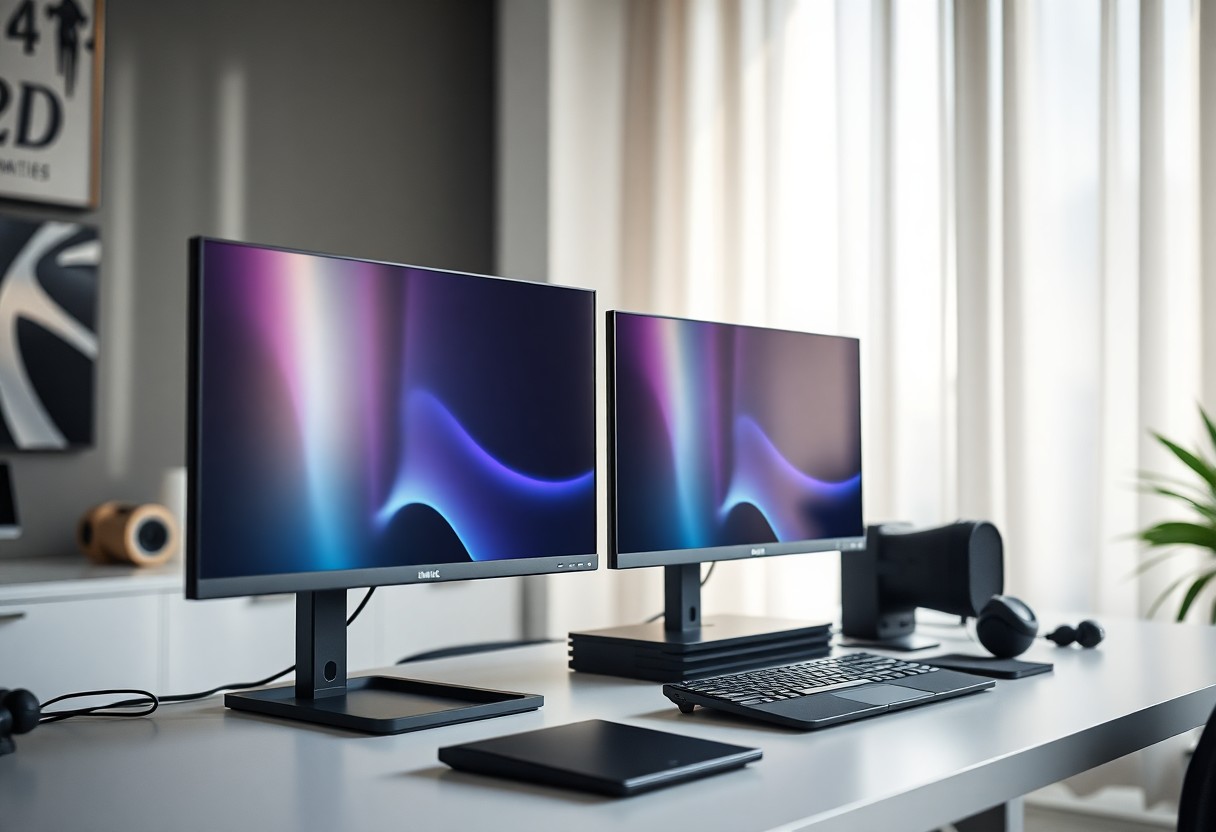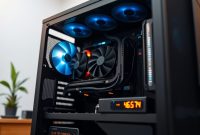Most professionals and gamers alike can greatly enhance their productivity and gaming experience by utilizing dual monitors. Setting up two screens allows you to multitask efficiently, whether you’re working on a project or playing your favorite game. In this guide, you’ll learn the crucial steps to configure your dual monitor setup seamlessly, ensuring that you maximize both your workspace and leisure time. Get ready to transform your desktop into a more dynamic and efficient environment!
Factors to Consider
For an effective dual monitor setup, you should weigh several factors to enhance your experience. These include:
- Monitor size and resolution
- Connectivity options
- Graphics card compatibility
- Desk space
- Ergonomics
The best setup will cater to both your work needs and gaming enjoyment.
Monitor Compatibility
Little thought goes into matching your monitors, yet it significantly impacts performance. Ensure that both monitors are compatible in terms of resolution and refresh rate for a seamless experience.
Graphics Card Requirements
With the right graphics card, you can maximize the potential of your dual monitor setup. Check if your graphics card supports multiple displays, ensuring you achieve the best performance.
This includes verifying the number of ports available and their types (HDMI, DisplayPort, etc.) to connect both monitors without hassle. Additionally, evaluating the GPU’s power to handle higher resolutions can enhance your experience, especially during gaming or graphic-intensive work.
Desk Space and Ergonomics
With a dual monitor setup, you need adequate desk space to accommodate your screens comfortably. Positioning your monitors at eye level can reduce strain and promote better posture.
Monitor placement affects ergonomics significantly. Make sure you can adjust both monitors’ positions to create a comfortable viewing angle. This will help you avoid neck and eye strain, allowing you to work and play more effectively over longer periods.

How to Connect Dual Monitors
While connecting dual monitors can enhance your productivity and gaming experience, it’s vital to understand the various options available for establishing those connections effectively. From identifying the ports on your devices to choosing the correct cables, this guide will simplify the process, allowing you to set up your dual-monitor system effortlessly.
Choosing the Right Cables
Even if your monitors and computer have similar ports, the type of cable you select can significantly impact performance. Common cable types include HDMI, DisplayPort, DVI, and VGA, each varying in capabilities such as resolution and refresh rates. Assess your monitors and PC to select a compatible cable for the best results.
Establishing Physical Connections
The first step in establishing physical connections is to power off your monitors and computer before plugging in your cables. Connect one end of your chosen cable to the monitor’s appropriate port and the other to your computer’s corresponding output. Be mindful of the cable’s length to ensure it reaches without strain.
Another aspect to consider is the arrangement of your monitors. Position them ergonomically for comfort and productivity, ensuring they are powered on and detected by your operating system. You might need to adjust display settings in your system preferences to configure the arrangement, like setting one as the primary display or extending the desktop across both screens.
Configuring Display Settings
Now that your monitors are physically connected, it’s time to configure the display settings for optimal use. This process allows you to customize how your screens operate, ensuring a seamless transition between work and leisure activities. You can adjust resolution, orientation, and arrangement to suit your preferences. Let’s take a closer look at how to tailor these settings for both Windows and Mac systems.
Windows Display Configuration
With Windows, right-click on the desktop and select “Display settings.” Here, you’ll see both monitors represented as rectangles. You can drag these to arrange them to match their physical layout on your desk, adjust each monitor’s resolution, and choose your main display. Make necessary adjustments for a harmonious multi-screen experience.
Mac Display Configuration
For Mac users, open “System Preferences” and click on “Displays.” In this section, you’ll find options to arrange your screens, set resolution preferences, and choose your primary display. It’s designed for effortless setup, enabling you to enjoy a fluid work interface.
Another useful feature in Mac Display Configuration is the “Mirror Displays” option, which allows you to show the same content on both monitors. This is particularly helpful when presenting or collaborating with others. You can easily toggle this setting depending on whether you need an extended desktop or a mirrored display, giving you utmost flexibility for different tasks.
Tips for Optimal Setup
To achieve the best experience with your dual monitor setup, consider these helpful tips:
- Position monitors at eye level.
- Adjust the distance according to your comfort.
- Use a consistent color profile across both screens.
- Organize your workspace to minimize distractions.
- Experiment with different layouts until you find what works best for you.
Recognizing these elements can significantly enhance your productivity and enjoyment during work and play.
Adjusting Display Orientation
To adjust the display orientation, access your display settings through your operating system. Most systems allow you to choose between landscape and portrait modes. This flexibility enables you to tailor your monitors to suit your tasks best. For example, portrait mode is ideal for reading long documents or coding, while landscape is perfect for gaming or multitasking with multiple windows.
Setting Up Extensions vs. Mirroring
Even though mirroring displays can provide a simple solution for presentations, using extended displays often yields better results for multitasking. This option allows you to have different content on each screen, which is beneficial for activities like video editing, programming, or simply keeping your email open while working on a document. Extended displays provide a larger workspace and greater flexibility in managing your applications.
Another advantage of using extension mode is that it allows your monitors to serve different purposes simultaneously. For instance, you can keep social media open on one screen while focusing on a work project on the other. This flexibility fosters a more efficient workflow, ensuring you can access critical information without interrupting your concentration. By understanding these differences, you can optimize your dual monitor setup to suit your unique needs.
Managing Application Windows
Many users find that dual monitors significantly enhance their workflow and gaming experiences. By effectively managing your application windows across screens, you can minimize distraction and streamline multitasking. After setting up your monitors, it’s important to learn how to arrange your applications, so they are easily accessible and organized. This will help you maintain focus whether you’re working on a project or enjoying your favorite game.
Effective Window Management Tools
The use of window management tools can greatly enhance your dual monitor experience. Software like DisplayFusion or WindowGrid allows you to customize how your windows behave and can help you snap them into place effortlessly. These tools enable you to create pre-defined layouts for different tasks, ensuring your workspace is optimized for productivity and enjoyment.
Keyboard Shortcuts for Efficiency
One effective way to manage your application windows is through keyboard shortcuts, which can save you time and effort when switching between tasks. Familiarize yourself with shortcuts that allow you to move windows seamlessly across screens or maximize and minimize applications with ease. This not only boosts your productivity but also creates a more enjoyable user experience.
Plus, incorporating these shortcuts into your daily routine can help you become more proficient in using your dual monitors. For instance, using shortcuts like Windows Key + P allows you to quickly change display settings, while Alt + Tab lets you switch between applications efficiently. By mastering these shortcuts, you can navigate your dual monitor setup with greater ease, freeing up time to focus on the tasks that matter most to you.
Troubleshooting Common Issues
Keep in mind that dual monitor setups can sometimes lead to unexpected issues. Fortunately, many problems have straightforward solutions. If you’re experiencing connectivity or display discrepancies, a few troubleshooting steps can quickly get your system back on track. Always start with the basics, like ensuring cables are firmly connected and that your graphics drivers are up to date.
Display Not Recognized
Troubleshooting can often resolve the problem of your dual monitors not being recognized. First, check the physical connections to ensure all cables are snugly in place. Then, navigate to your display settings and manually detect the monitors. If they still aren’t appearing, consider updating or reinstalling your graphics drivers to establish a proper connection.
Resolution Problems
Now, resolution problems can be a common pain when using dual monitors. Ensure both screens display in their native resolutions to avoid distortion or display issues. Adjustments can typically be made through your computer’s display settings, allowing you to choose the correct resolution for each monitor based on its specifications.
Recognized resolutions for each monitor differ, so you should consult the manufacturer’s specifications to understand the optimal settings. By ensuring both displays are configured correctly, you will enjoy a seamless visual experience. If you notice that one monitor is displaying poorly, revisit the display settings and tweak them until each screen looks just right.
Final Words
On the whole, setting up dual monitors for work and play enhances your productivity and gaming experience simultaneously. By carefully selecting the right monitor types, using proper cables, and configuring your display settings, you can create a seamless dual-monitor setup that caters to your needs. Whether you’re multitasking for work or venturing into an immersive gaming session, taking the time to customize your workspace will undoubtedly elevate your overall experience. Enjoy the benefits of increased screen real estate as you navigate effortlessly between tasks.



